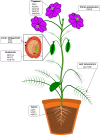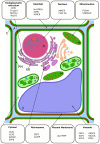Plant proteases during developmental programmed cell death
- PMID: 30793182
- PMCID: PMC7612330
- DOI: 10.1093/jxb/erz072
Plant proteases during developmental programmed cell death
Abstract
Proteases are among the key regulators of most forms of programmed cell death (PCD) in animals. Many PCD processes have also been associated with protease expression or activation in plants, However, functional evidence for the roles and actual modes of action of plant proteases in PCD remains surprisingly limited. In this review, we provide an update on protease involvement in the context of developmentally regulated plant PCD. To illustrate the diversity of protease functions, we focus on several prominent developmental PCD processes, including xylem and tapetum maturation, suspensor elimination, endosperm degradation, and seed coat formation, as well as plant senescence processes. Despite the substantial advances in the field, protease functions are often only correlatively linked to developmental PCD, and the specific molecular roles of proteases in many developmental PCD processes remain to be elucidated.
Keywords: Developmental PCD (dPCD); development; plant; programmed cell death (PCD); protease; protein degradation.
© The Author(s) 2019. Published by Oxford University Press on behalf of the Society for Experimental Biology. All rights reserved. For permissions, please email: journals.permissions@oup.com.
Figures



References
-
- Ariizumi T, Higuchi K, Arakaki S, Sano T, Asamizu E, Ezura H. Genetic suppression analysis in novel vacuolar processing enzymes reveals their roles in controlling sugar accumulation in tomato fruits. Journal of Experimental Botany. 2011;62:2773–2786. - PubMed
-
- Ariizumi T, Toriyama K. Genetic regulation of sporopollenin synthesis and pollen exine development. Annual Review of Plant Biology. 2011;62:437–460. - PubMed
-
- Avci U, Earl Petzold H, Ismail IO, Beers EP, Haigler CH. Cysteine proteases XCP1 and XCP2 aid micro-autolysis within the intact central vacuole during xylogenesis in Arabidopsis roots. Plant Journal. 2008;56:303–315. - PubMed
Publication types
MeSH terms
Substances
Grants and funding
LinkOut - more resources
Full Text Sources

